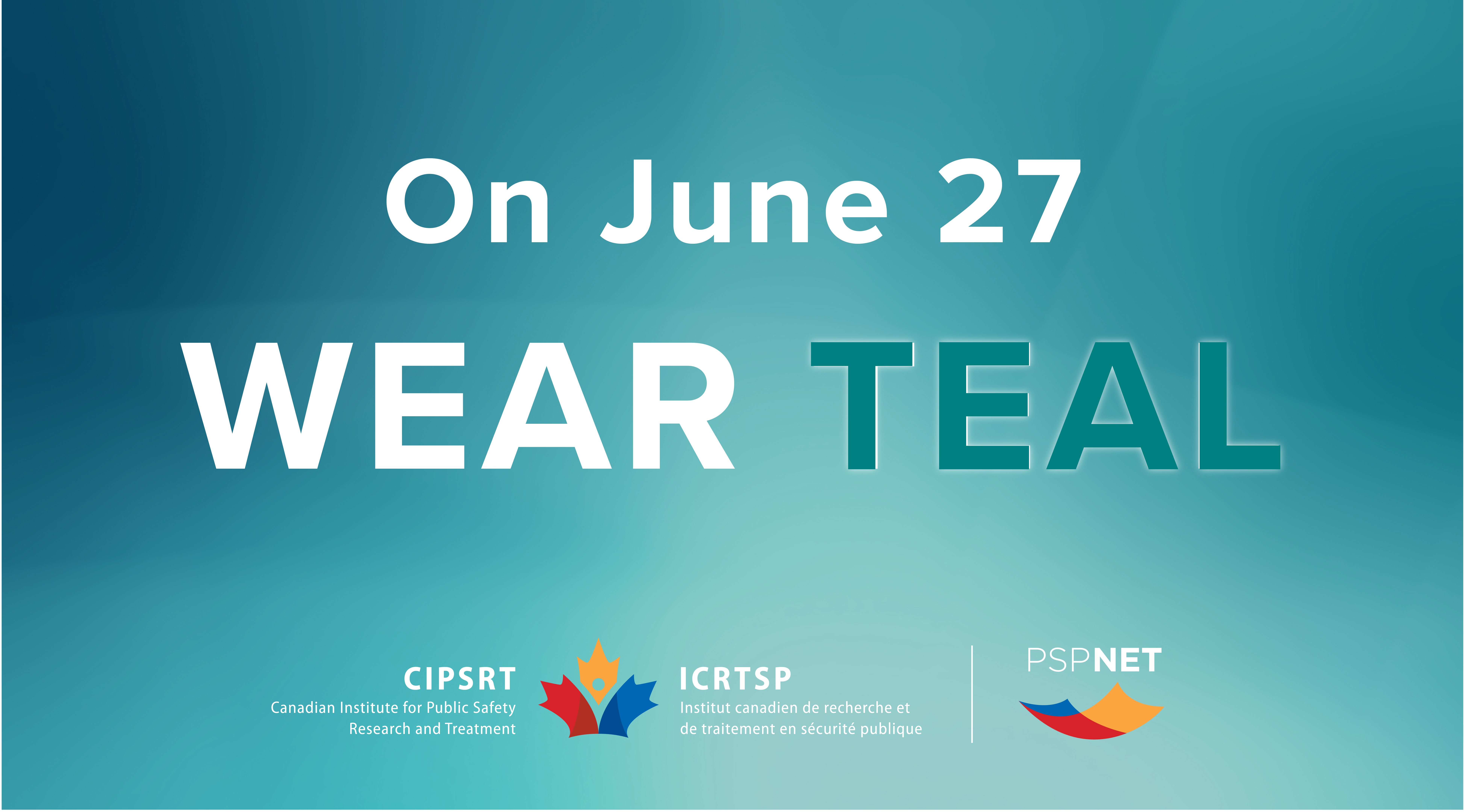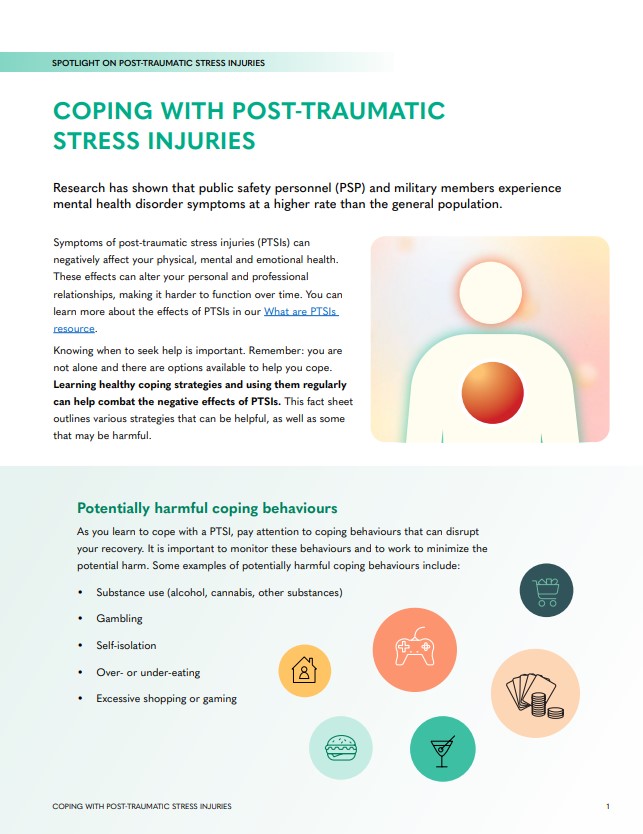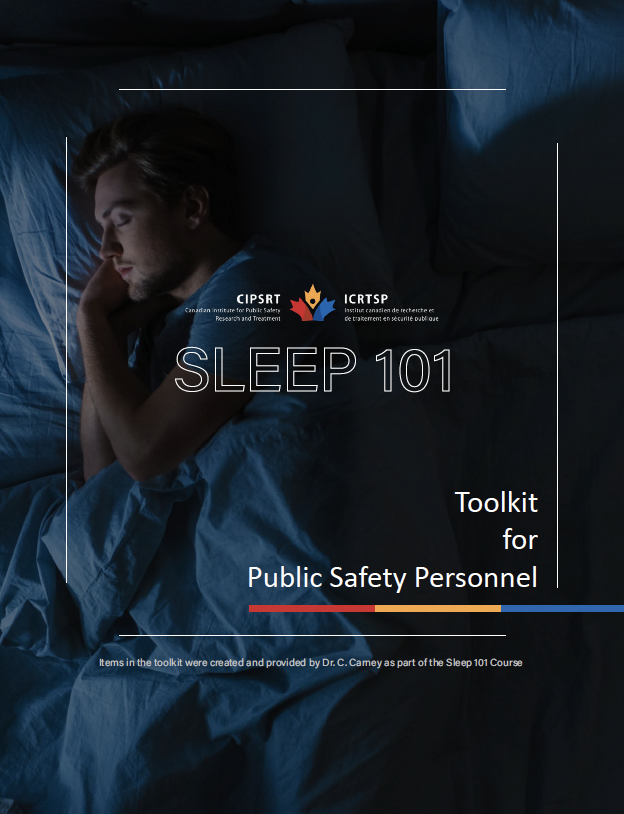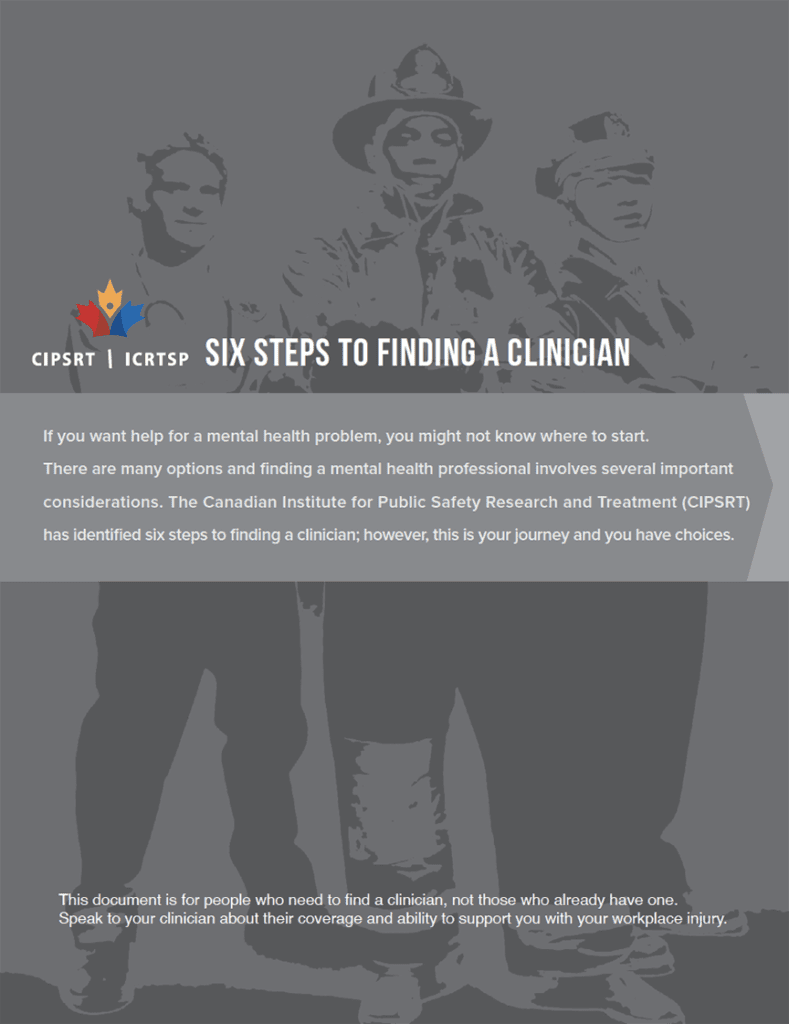PTSD: Stigma Out, Understanding In – 2023
In Canada it is estimated that up to 2.3% of the population is dealing with Posttraumatic Stress Disorder (PTSD) at any moment. Among public service personnel (PSP), that figure is much higher. Research done through the CIPSRT consortium shows that number may be over 23% for public safety personnel. Research from the ongoing RCMP Study has found that among the many serving RCMP suffering from PTSD, an estimated half are impacted by one or more mental health injuries.
Along with struggling with symptoms of PTSD, PSP may also feel the weight of stigma from their co-workers, organizations, or the public. Lack of understanding of PTSD can lead to the idea that those that struggle with PTSD are weak or unfit for duty. This stigma can stop those who are suffering from seeking help or asking for support. Understanding the reality of symptoms and debunking myths about PTSD can help improve the lives of people who are struggling.
This year for PTSD awareness month CIPSRT wants to get Stigma Out and Understanding In. Together we can show that while PTSD is invisible, it is not invincible.
Join us for our 4th annual Wear Teal Challenge. Last year organizations and individuals from across Canada wore teal to show their support and raise awareness for individuals living with PTSD. We want to make an even greater impact this year – join us!
Post your photos on June 27th and tag CIPSRT using #WearTealChallenge and #StigmaOutUnderstandingIn.
Facebook: @CIPSRT-ICRTSP
Twitter: @CIPSRT-ICRTSP
LinkedIn: @CIPSRT-ICRTSP

PTSD The Basics: This short video shares the basics about PTSD and PTSD treatments
What Is Posttraumatic Stress Disorder?
Posttraumatic Stress Disorder (PTSD) is a group of symptoms people might develop after experiencing a potentially traumatic event.
What Is a Potentially Traumatic Event?
When a mental health professional is evaluating whether someone has PTSD, they often consider the experience or situation thought to have triggered the symptoms. A traumatic event is different than normal daily stress or pressure. Potential traumas usually involve experiencing or witnessing severe injury, feeling that your life or somebody else’s life is in danger, or witnessing an intentional or accidental death. Events such as natural disasters can also be traumatic.
The kinds of potentially traumatic events that can lead to PTSD are often experienced in person, but not always. For example, some work involves repeated exposure to stories of injury or death – like being a call centre operator for 911 or a crime scene photo developer for a police unit.
Not everybody who experiences a traumatic event develops PTSD. Indeed, in the North American general population most people (i.e., 50-90%) will experience one or more potentially traumatic events during their lifetime; however, relatively few (i.e., 5-10%) will develop PTSD. Even people who are in careers where exposure to potentially traumatic events may be more common, like public safety personnel, are not necessarily going to develop PTSD. There are responses to potentially traumatic events that can be considered fairly normal. For example, you might feel unsettled or uncomfortable at first, but most people recover and return to normal within a few days; however, some people do go on to have longer-lasting challenges after experiencing a potentially traumatic event.
PTSD Symptoms after Trauma
There are four types of PTSD symptoms a person might experience after being exposed to a potentially traumatic event.
Re-experiencing symptoms
A hallmark symptom of PTSD involves re-experiencing the traumatic event. This may occur in the form of unwanted and upsetting memories of the event, or repeated and distressing nightmares. Some people have more intense re-experiencing events called “flashbacks,” where they might feel like they are actually experiencing the trauma again.
Avoidance symptoms
Avoidance symptoms include a strong urge to stay away from reminders of a potentially traumatic event. These reminders might include people, places, objects, or activities which are related to the trauma in some way. Some people also go out of their way to avoid thinking or talking about the event.
Changes in your thoughts and mood
Potentially traumatic events can change how people think about themselves, other people, and their world. The changes can include feeling hopeless, detached from loved ones, or difficulty experiencing positive emotions – or sometimes any emotions – at all. Such changes might indicate PTSD, especially for people who were ‘positive’ or ‘realistic’ person but have become increasingly ‘negative’ after a potentially traumatic event.
Changes in physical and emotional reactions
Potentially traumatic events can also cause significant distress and physical symptoms. People can become more watchful, on guard, easily startled, or frightened. Difficulties sleeping or trouble concentrating can be caused by diverse stress, up to and including traumatic stress. In addition, potentially traumatic events can cause increased feelings of anger, irritability, shame, or guilt.
Many people can experience some of the above symptoms after a potentially traumatic event; nevertheless, for most people the symptoms fade within a couple weeks.
If someone experiences several of the above symptoms from each of the four groups for longer than a month, and the symptoms are extremely distressing or interfere with work, relationships, or other important areas of life, they may be experiencing PTSD and may benefit from appropriate mental health care.
If you think that you or someone you know might be experiencing these symptoms, click here to take a short, anonymous questionnaire to screen for PTSD.
While PTSD has many negative impacts, there are interventions that can be very effective at treating the symptoms. To learn more about how PTSD can be treated and how you can access resources, read the following section on Understanding PTSD Treatment.
References and Further Reading
Understanding PTSD Treatment
There are many treatments available for PTSD that have been supported by several rigorous peer-reviewed research projects (i.e., empirically-supported treatments). Such therapies, when provided by appropriately trained professionals, can help reduce PTSD symptoms, improve quality of life, and develop skills maintaining good mental health.
Empirically-Supported Treatment
Cognitive Processing Therapy (CPT)
Traumatic experiences can have ripple effects through many areas of life. Once the effects are identified, a CPT therapist can help a person to work towards solutions and generate a more adaptive way of moving forward. CPT can help a person to think differently about the negative thoughts they have regarding a trauma. Doing so can change how a person feels about and interacts with the trauma, which can reduce the impact of PTSD symptoms in many different parts of a person’s life. CPT involves talking with a therapist about the negative thoughts related to a trauma and doing short writing assignments.
Eye-Movement Desensitization and Reprocessing (EMDR)
Traumatic experiences can be difficult to make sense of and change the way a person thinks about the world. For some people discussing the trauma can be too difficult. Eye-Movement Desensitization and Reprocessing (EMDR) can help a person process and make sense of a trauma, which can help reduce PTSD symptoms. EMDR involves a person recalling a trauma in their own mind while paying attention to a back-and-forth movement or sound (e.g., a finger waving side to side, a light, a tone) produced by a therapist.
Prolonged Exposure (PE)
Imagine a child who is very afraid of swimming – how would you help the child overcome their fear? Perhaps, “start small with a sprinkler, work up to a shallow pool, eventually working up to a deeper pool, and perhaps eventually to a lake or ocean”? Essentially you want to help them gradually develop new skills, confront their fears, and decrease their anxiety. Prolonged Exposure, or PE, helps a person confront difficulties with trauma in a similar fashion. Once a person has identified their challenges, developed their goals, and is comfortable enough with their therapist, they can gradually confront their trauma with help from their therapist. Gradual exposure to the trauma story (starting small and working up slowly) in a safe and therapeutic environment can help to reduce PTSD symptoms. Therapists can help to make sense of traumatic experiences and find ways to move forward towards an improved quality of life.
Empirically-Supported PTSD Treatments
In addition to the above treatments, the American Psychological Association suggests Narrative Therapy and Brief Eclectic Therapy are promising therapies, and researchers are currently exploring how well they work in different settings with different populations. In all cases, persons interested in PTSD treatment should consult with an appropriately trained professional. If you would like more information comparing PTSD therapy options, click here.
References and Further Reading
- https://www.apa.org/ptsd-guideline/ptsd.pdf
- https://www.ptsd.va.gov/public/ptsd-overview/basics/what-is-ptsd.asp
- https://www.ptsd.va.gov/public/understanding_ptsd/booklet.pdf
Mental Health Resources
PSPNET
The Government of Canada’s Action Plan on Posttraumatic Stress Injuries (PTSI) has identified the need for greater access to effective care and treatment tailored explicitly for PSP. Through PSPNET, CIPSRT is playing a leading role in developing and offering accessible, secure, and innovative evidence-based interventions to current and former public safety personnel, their leaders, and their families through internet-delivered cognitive behavioural therapy.
Evaluation from Public Safety Canada has identified:
- PSPNET has a unique set of attributes, including being designed for public safety personnel, using clinicians that specialize in treating trauma in the public safety setting, being confidential, and being free to access.
- PSPNET’s early results indicate that it is effective in assisting public safety personnel who are experiencing the effects of trauma, and there is a desire to see it expand to other jurisdictions.
Treatment options available to public safety personnel through PSPNET include:
Therapist-guided courses available to PSP living in SK, QC, NB, NS, PEI, and ON
Self-guided courses available to PSP or spouses or significant others of PSP living anywhere in Canada
The Canadian Institute for Pandemic Health Education and Response (CIPHER)
The Canadian Institute for Pandemic Health Education and Response (CIPHER) was founded in order to provide support for our public safety personnel (PSP), military personnel and healthcare providers suffering from the symptoms of Posttraumatic Stress Disorder (PTSD), especially after the emergence of COVID-19. CIPHER strives to not only understand those struggling to cope with their trauma from their everyday lives and jobs, but to also provide a variety of mental health resources, fit for everyone’s personal needs. The CIPHER website is designed to assist you, friends, and family members struggling with mental health disorders, such as PTSD, to navigate your way through resources fitted for your or their every need. To learn more about CIPHER, its goals and the other nine projects it supports, please visit their website: https://cipher-iceisp.ca/
PSP Mental Health Website
https://www.pspmentalhealth.ca is an online resource featuring over 300 programs and resources to assist PSP and their families. The programs and resources can be filtered by location, cost, delivery method, and more! Visit the website today to find the program that’s right for you.
PeerOnCall
PeerOnCall and PeerOnCall Support, the mobile health apps customized for Canadian public safety personnel, have been created to promote early intervention, mental health support, and psychological health and safety in public safety workplaces, including corrections, emergency communications, fire services, law enforcement and paramedic services.
For more information, please visit: https://www.oncallapp.ca
Videos for you
Produced in partnership with the Atlas Institute for Veterans and Families and through generous funding from the Medavie Health Foundation, the videos below aim to raise awareness about the impacts of PTSD and PTSIs on public safety personnel and their families.
Supporting yourself when you loved one is struggling with a Post-Traumatic Stress Injury
Public Safety Personnel and Post-traumatic Stress Injuries
Coping with PTSI
Produced in partnership with the Atlas Institute for Veterans and Families and through generous funding from the Medavie Health Foundation, the videos below highlight the lived experiences of PSP in dealing with trauma and occupational stressors, in their own words. These resources aim to increase awareness about PTSIs, reduce stigma, and support the well-being of fellow PSP and their families.
Words from Public Safety Personnel Families: Amanda, Laryssa, and Ian
Words from Public Safety Personnel: Bruno
Words from Public Safety Personnel: Pam
Words from Public Safety Personnel: Todd
Words from Public Safety Personnel: Lauren
Words from Public Safety Personnel: Amber
The following webinars offer a more comprehensive look at PTSD and its impacts.
In PTSD Crash Course, Clinical Psychologist Dr. Megan McElheran explores the facts about PTSD among public safety personnel.
And in Finding a way forward: The unexpected feeling of growth that can come after trauma, Dr. Samantha Horswill discusses the experience of post-traumatic growth – what it is and what it isn’t.
PTSD Crash Course
Finding a way forward
Additional Resources
Download these additional resources for understanding and coping with PTSD and PTSIs, as well as seeking treatment.
Coping with Posttraumatic Stress Injuries
Download PDFSleep 101 Toolkit
Download PDFSix Steps to Finding a Clinician
Download PDF


